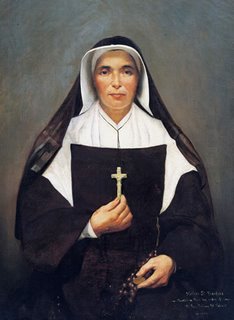The precipitous decline of Iraq's ancient Christian community has finally received
front-page treatment in the
New York Times:
Christianity took root here near the dawn of the faith 2,000 years ago, making Iraq home to one of the world's oldest Christian communities. The country is rich in biblical significance: scholars believe the Garden of Eden described in Genesis was in Iraq; Abraham came from Ur of the Chaldees, a city in Iraq; the city of Nineveh that the prophet Jonah visited after being spit out by a giant fish was in Iraq.
Both Chaldean Catholics and Assyrian Christians, the country's largest Christian sects, still pray in Aramaic, the language of Jesus.
They have long been a tiny minority amid a sea of Islamic faith. But under Saddam Hussein, Iraq's million or so Christians for the most part coexisted peacefully with Muslims, both the dominant Sunnis and the majority Shiites.
But since Mr. Hussein's ouster, their status here has become increasingly uncertain, first because many Muslim Iraqis framed the American-led invasion as a modern crusade against Islam, and second because Christians traditionally run the country's liquor stores, anathema to many religious Muslims.
Over the past three and a half years, Christians have been subjected to a steady stream of church bombings, assassinations, kidnappings and threatening letters slipped under their doors.
Estimates of the resulting Christian exodus vary from the tens of thousands to more than 100,000, with most heading for Syria, Jordan and Turkey.
The number of Christians who remain is also uncertain. The last Iraqi census, in 1987, counted 1.4 million Christians, but many left during the 1990's when sanctions squeezed the country. Yonadam Kanna, the lone Christian member of the Iraqi Parliament, estimated the current Christian population at roughly 800,000, or about 3 percent of the population. A Chaldean Catholic auxiliary bishop, Andreos Abouna, told a British charity over the summer that there were just 600,000 Christians left, according to the Catholic News Service. [Click here to read the CNS article in which Bishop Abouna's comments appeared.]
One of my greatest fears at the start of the present war in Iraq was that the conflict would have a disastrous impact on the country's venerable Christian churches. In some sense, my concern for the fate of Iraq's Christians reflects my broader interest in Eastern Christianity. Those of us whose roots are in the Christian West can be forgetful of Christianity's Middle Eastern roots. We often fail to recognize that the ritual practice and spirituality of Christian churches rooted in the Mideast - including the
Chaldean and
Assyrian churches of Iraq - have more in common with the earliest Christian communities than Western churches do. Over the past few years, I've been blessed to have contact with Middle Eastern Christians - first on a trip I made to Israel and Palestine as an undergraduate, and more recently during my time in the novitiate. Metro Detroit is home to one of the largest Chaldean Catholic communities outside Iraq, and as a novice I occasionally worshipped in Chaldean parishes. On rare but memorable Sundays, I found myself drawn to the Chaldean liturgy, not just by the beauty of the ritual and the haunting Aramaic chants but also by the desire to stand in solidarity with the Church suffering.
Over the past three years I've closely followed reports on the state of Iraq's churches, and I worry that my fears about a mass exodus of Iraqi Christians are being realized. Though today's
NYT article paints a fairly bleak picture of the situation, other media reports are even more pessimistic. Chaldean bishop Andreos Abouna offers some grim statistics in
a CNS report from early August, claiming that half of the Christians in the country have left since 2003 and doubting whether many will return.
A recent article in the Guardian reports on the worsening situation of Christians in provincial cities like Mosul and notes that Christians make up a large proportion of Iraqis seeking asylum in neighboring countries. Unlike the
NYT, the Guardian assigns some of the blame for the Christians' plight to U.S.-led coalition forces, which have apparently done little to protect Iraqi Christians from growing intolerance and the constant threat of sectarian violence. On a broader level, I believe that Iraqi Christians have suffered through the indifference (or perhaps simply ignorance) of American policymakers. The government seems to view Iraq simply as a patchwork of Kurds, Shiites and Sunnis; always left unmentioned by U.S. officials, Iraq's ancient Christian community is apparently regarded as irrelevant to the country's future or perhaps simply too small to merit notice. At times, I wonder whether the Bush administration's desire to make Iraq a laboratory for a specifically Islamic brand of democracy has helped worsen sectarian conflict in the country. By raising the public profile of religion in a previously secular state, the administration may have jeopardized the fragile position of a small religious minority.
Up to now, the news media haven't done much to educate the public about the abysmal situation of Christians in Iraq. Outside of occasional articles in Catholic publications, I've seen almost no reporting of the plight of Iraqi's Christian population - or even much acknowledgment that Iraq
has an indigenous Christian population. Today's front-page story in the
New York Times represents a step in the right direction, but much more needs to be done. What can we - you and I - do to change things? We can tell others - friends, reporters, politicians - what's going on. We can support relief organizations like
Aid to the Church in Need and
CNEWA, which are working to help Iraq's embattled Christian population. Above all, we can pray for the Christians of Iraq. Let us dare to hope that one of the first countries to hear the Gospel will have a living Christian presence for centuries to come. AMDG.





